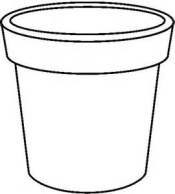Try out this simple cactus acrylic painting lesson! It focuses on blending colors directly on the surface and painting a simple object from direct observation. I do this with my sixth graders, but it could totally be adapted for a range of age groups. This lesson has three simple steps to grow confident and creative painters in your classroom.

Cactus Acrylic Painting Tutorial
This cactus acrylic painting tutorial will walk you through each step of this painting! I also break everything down in this post if you prefer to read instead, but this tutorial is ready for your classroom.
Step One: BACKGROUNDS
Painting the background is my favorite part of this artwork. It is the most free and loose method and students are always receptive to class periods of painting without it having to look exactly like something. Realism can be scary for young art students or beginners!
I have done this where students sketch their cactus first and then paint their background, and students had a really hard time trying to paint around their sketch. Starting with backgrounds first allows for unity within the painting as well as building confidence. My students have three color scheme options: warm, cool or gray.

I pre-poured (okay, okay…I had some trusted student helpers pre pour) about eight palettes of each color scheme. Each time I teach this the colors change slightly, depending on what acrylic paint I currently have, but I limit to three colors. Those who choose gray can pick one other color from either color scheme to add to their palette.
My tutorial demonstrates really smooth blending, and I like to encourage my students to experiment with directional brush strokes and to mix their colors wet-on-wet in whatever order they find appealing. Having only three colors from the same color scheme to work with really helps students feel free to experiment because no matter what their backgrounds colors work together. Most students will finish this in one class period, depending on how long it is and the size of the paper.
Part Two: SKETCH & CONTAINER
The next class period we spend only a few minutes sketching on top of our dried backgrounds. I like to encourage students to use their paintbrush as their pencil, and let me tell you they always want to rebel against this concept! It seems so scary to not draw it out exactly, but I try to encourage more intuitive painting. I do think having the container being sketched in more detail has helped students feel more confident.
I have a variety of mini cactus and succulent plants I hold up to the document camera. We look at the shape of the container and how to make it look 3D. I love holding it directly under the camera so the opening is a perfect circle and then slowly changing it into an ellipse and then back to a circle again. I have found having simple clip-art images available help with students confidence when sketching their general container shape.

Finally, we draw a very simple cactus shape to make out the size of their cactus. I have a few that we look at directly and I advise students to have the top of their cactus hit about the 2/3 mark of their paper. Do we measure? Nope.
During the same class period as the sketching, we start painting our container. They watch my tutorial from the 9:07-12:57 mark and I use that time to pour white paint on their palettes. Containers can be any color, but I have been using gray, burnt umber and burnt sienna lately and loving the natural results.
I have found that if I paint at the document camera as they paint, the results are stronger and students feel more confident. It’s one thing to watch someone do something once, but painting synchronously allows for their brains to snap into focus in real time. I always do this with a MUCH smaller piece of white paper so I don’t waste materials or time. If I am feeling lazy, I just walk around and monitor progress as they paint, but the results are always better when I take time to model the technique along with them.
Part Three: CACTUS!
Finally, it’s time to paint the cactus. Students mix their own green and paint a vertical section or two at a time, adding white to create depth and texture. Students also pull their brush to create spikes before the paint dries, or add small dots or other areas of texture based on their observations.








A final step is the optional flower. I have learned that practicing brushstrokes is very helpful before we painting this finishing detail. I have students sketch a very basic flower on the back of their paper. Then we practice brush strokes adding a little white or black the their chosen base color for depth. Every technique is wet on wet directly on their paper, but color mixing on their palette is certainly an option.
If you want to make this a mixed-media lesson, try out this Mixed Media Cactus Plant Still Life lesson. I love the collage element and the aloe vera plant is SO much fun to paint! I decided to simplify my life this school year and teach a single cactus focusing just on painting. I have gotten some fantastic results with the more in-depth mixed media approach!
Cactus Still Life Painters to Explore
Connecting art history and practicing artists is key to a balanced art education. Here are my favorites to show students during our sketchbook warm-ups during this Cactus Acrylic Painting Lesson.
- Anna Valdez: I love her bold colors and busy compositions. I also love that she is young, alive and still making art!
- Fritz Schwimbreak: His cactus paintings are gorgeous and his craftsmanship






